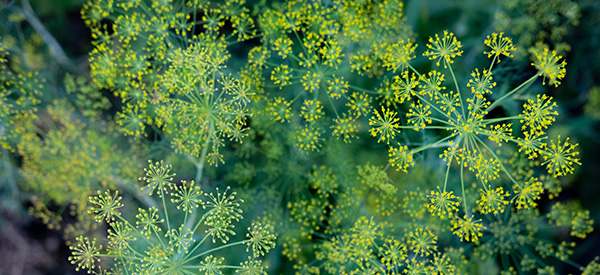
Dill
Dill (Anethum graveolens) has many names as it is known for its culinary and medicinal uses in many parts of the world. It grows as an annual herb of the celery family, Apiaceae. Originating in the Mediterranean, dill is found throughout Europe and Asia and in many international cuisines.
Dill means to calm or soothe. The name may originate from the plant’s ability to calm colicky infants and soothe digestive issues. Dill is the only plant in the Anethum genus. Its second name, graveolens, is a combination of gravis which means heavy, and oleo, which means emitting an odor. The combination word, graveolens, is defined as having a strong or heavy odor.
Dill weed, the fresh or dried fern-like leaves, are deliciously aromatic. These are used to flavor many favorite dishes. It is a key ingredient in many soups such as borscht and sauces such as tzatziki. The weed is best used fresh but will retain flavor well for several months when fresh-frozen or when dried quickly. Dill weed is best used at the end of cooking or in uncooked foods such as salads and yogurt-based sauces.
Dill seed is used to flavor many foods as well. They are often used fresh or dried, whole, or crushed in meat, fish, and egg dishes. Famously, the seed is used in making pickles. Due to the hard seed coating, the seed is used at the beginning of cooking to allow the sweet, refreshing flavor to infuse into the meal.
The History of Dill
Originating in the Mediterranean area, dill has a long history dating back to early Egypt over 5,000 years ago. It was known to grow in the gardens of Babylonians through 3,000 BCE.
It has been used in Ayurveda medicine since ancient times.
Dill symbolizes good fortune and prosperity. As a highly valued herb, it was taxed or tithed in a variety of cultures.
The seeds were chewed to freshen breath and calm digestion. The seed was called ‘meetinghouse seed’ because they were chewed during long religious services and helped to keep children quiet.
Dill became popular throughout England in the seventeenth century. It was often grown in kitchen gardens in many cultures. This tradition continued with new settlers to North America.
Today, dill is an important culinary herb grown around the world with the top exporter being India and the top importer being the USA.
Where Dill is Found
This plant is a common herb grown in vegetable and herb gardens. Because of its delicate nature, it has a short shelf life. Fresh weed can be found in the fresh herb section of grocery stores while dried weed and seed are available in the spice section.
Related: The Complete Map of Edible Plants: Find Out What You Have in Your Area! (Video)
How to Identify Dill
- Shape: Tall, upright plants reach 16 to 48 inches tall depending on the growing conditions and cultivar.
- Leaves: Finely divided, soft, lace-like leaves are 4 to 8 inches long. The divided leaf structures are very slender, less than 1/32 of an inch wide.
- Flower: White to yellow flowers top the plants in large 2-to-4-inch umbels or umbrella-shaped flower clusters.
- Stem: Straight, slender stems are hairless. They are alternately branching with off-white lines or striations which run vertically.
- Fruit & Seeds: Seeds are oblong, bright green, turning dark brown when ripe. They form at the tops of the umbels and are less than ¼ inch long.
Related: Plant Identification Guide – 400 Wild Plants That You Can Forage For (Video)
How to Grow Dill
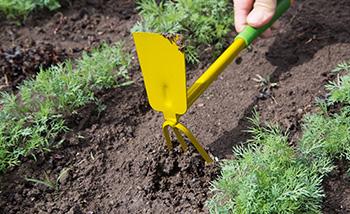
Dill loves a warm sunny spot in rich, moist, well-draining soil. Like its parsley and carrot cousins, it is best sown by direct seeding. Due to its long taproot, it does not transplant easily. Similar also to carrot, dill seed should stay continuously moist during the 10-to-14-day germination period. For ongoing bright green weed harvests, dill does well with succession planting. Reseed every few weeks in spring.
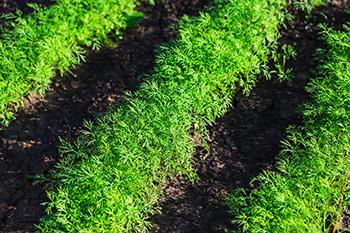
It attracts a bounty of beneficial insects with its flowers and is a preferred food of black swallowtail butterflies. It is also loved by aphids which are often found in clusters at the base of the flower umbels. These may be welcome to encourage healthy populations of beneficials such as ladybugs and parasitic wasps. Otherwise, aphids are easily washed away with direct water spray. When using the seed-covered umbels in cooking or making pickles, a quick douse into cool salted water and a rinse usually takes care of any unwelcomed little guests.
Related: 10 Plants That You Should Never Plant Together (Video)
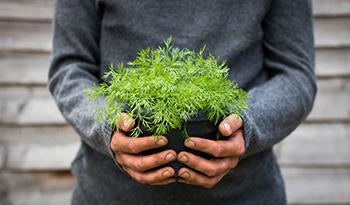 If dill is allowed to go to seed, the ripe seeds easily fall off the plant. The seeds may remain in the soil for 3 to 10 years. They may reliably germinate under favorable moist conditions. In the past, I had trouble growing dill. Once I allowed them into the vegetable patch that stays well-watered in the spring, it became a prolific self-seeder. The lovely unique aroma flavors many summer mornings, as I freely admit, they are everywhere.
If dill is allowed to go to seed, the ripe seeds easily fall off the plant. The seeds may remain in the soil for 3 to 10 years. They may reliably germinate under favorable moist conditions. In the past, I had trouble growing dill. Once I allowed them into the vegetable patch that stays well-watered in the spring, it became a prolific self-seeder. The lovely unique aroma flavors many summer mornings, as I freely admit, they are everywhere.
Dill is an excellent companion plant for cabbage and onions. Research states that they shouldn’t be grown with carrots. This year, my plant has infiltrated the carrot rows, so we’ll see how the carrot crop is doing come harvest time.
How to Harvest Dill
Dill weed’s harvest season is much too fleeting. Also, some years are much better than others. Begin harvest once the plants have four to five leaves. As dill has seeded itself everywhere, I pull up entire stalks to thin them out.
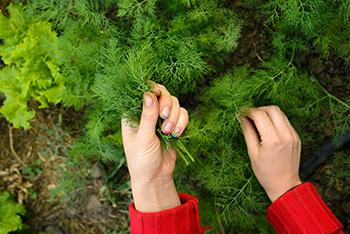 Catching the harvest early in the season has several benefits. At least here in my garden, the spring dill harvest is best for flavor. If I’m lucky enough, I get to the plants before the aphids which makes harvesting and processing much easier.
Catching the harvest early in the season has several benefits. At least here in my garden, the spring dill harvest is best for flavor. If I’m lucky enough, I get to the plants before the aphids which makes harvesting and processing much easier.
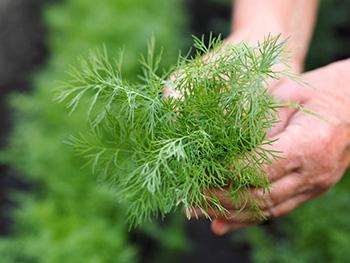 To process the harvested dill, pinch off all the best-looking leaves from the plants. Quickly douse in cold salted water and shake off excess water. Once dry enough, finely chop the needle-like leaves. These can then be dried or frozen for use throughout the next 6 months to a year. I think frozen is better, so I place the freshly chopped leaves in a recycled glass jar and throw it in the freezer for future use.
To process the harvested dill, pinch off all the best-looking leaves from the plants. Quickly douse in cold salted water and shake off excess water. Once dry enough, finely chop the needle-like leaves. These can then be dried or frozen for use throughout the next 6 months to a year. I think frozen is better, so I place the freshly chopped leaves in a recycled glass jar and throw it in the freezer for future use.
Throughout the remaining growing season, pluck fresh bright green ferny leaves from plants whenever you need that special dill flavor in the kitchen. In this way, you save the best of the spring harvest for fall and winter cooking.
At pickling time, harvest seeds in their bright green stage for making brine and packing the umbels in the pickle jars. The ripened dry brown seed is ready to harvest when it falls easily off the stems. Gather ripened seed heads and place them upside down in a paper bag or container to catch the falling seed. Inspect the seeds for any crawling friends. Once clean and dry, seeds can be placed in an airtight container.
What Dill Is Good For & The Natural Remedies Made From It
In ayurvedic medicines, dill is used as a carminative for antiflatulence, stomachic for digestive aid, and diuretic to increase the production of urine. It is used in over 56 ayurvedic preparations. It is an ingredient in gripe water and is known to help relieve colic pain in babies and flatulence in young children.
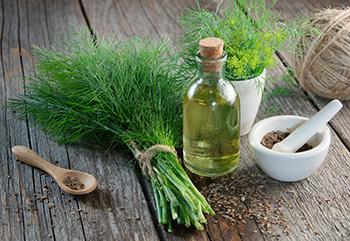
Dill essential oil is carminative. It aids intestinal spasms, aids digestion, improves appetite, and relieves gas. Chewing the seed is known to improve bad breath. Anethum is also given to milk cows to stimulate milk flow. There is evidence that it improves urinary complaints, piles, and mental disorders.
It is also used used as a condiment and added to food for flavoring. It can also be made into a tea and as mentioned, dill essential oil.
Related: Add This “Unusual Nutrient” to Coffee or Tea, to Effortlessly and Fully Empty Your Bowels Every Single Morning (Learn More)
What Parts of The Dill Plant Are Used In Remedies?
The seed, weed, stems and flowers are used in remedies. The plant is rich in antioxidants. It is also a good source of vitamin A and C, and magnesium, but the quantities of dill in a normal diet are small and may not contribute much nutritional value. Carvone, limonene, coumarins, flavonoids, phenolic acids, and myristicin are the important odorants of the plant.
Two DIY Recipes – Seed Tea and Garlic Dip
Dill and Garlic Dip
Ingredients:
- ½ cup chopped dill weed.
- 1 clove of garlic.
- 1 cup of plain yogurt. In this recipe, I indulged in rich, creamy Greek-style yogurt. Fat-free yogurt is optional for a healthier dip.
Method
Step 1: Gather and wash fresh dill weed.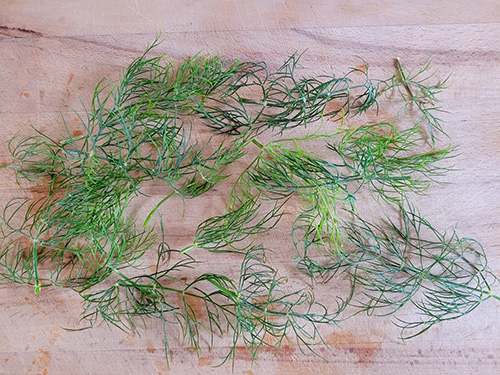
Step 2: Finely chop dill weed. Source 1 clove of garlic.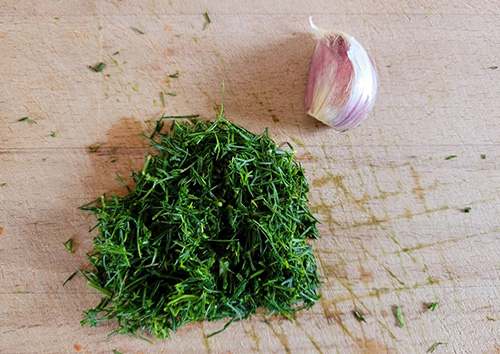
Step 3: Finely chop or crush the garlic. Place in a container for mixing.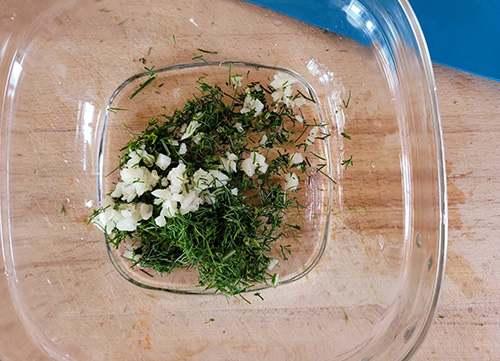
Step 4: Add your choice of yogurt.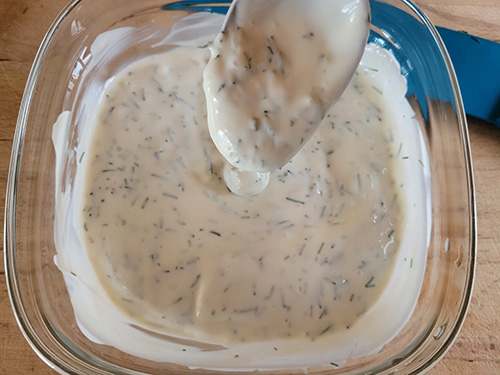
Step 5: Stir, mixing all ingredients together. Add salt and pepper to taste.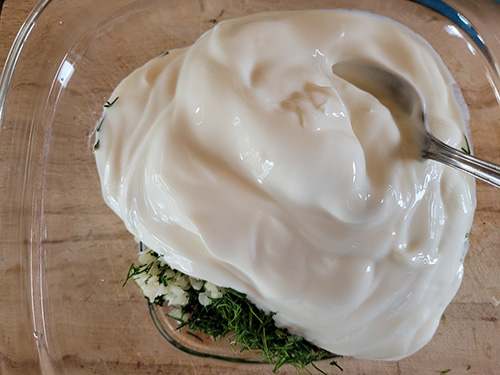
Step 6: Serve. Add in grated cucumber or other vegetables with the juice squeezed out for raita or tzatziki-like sauce.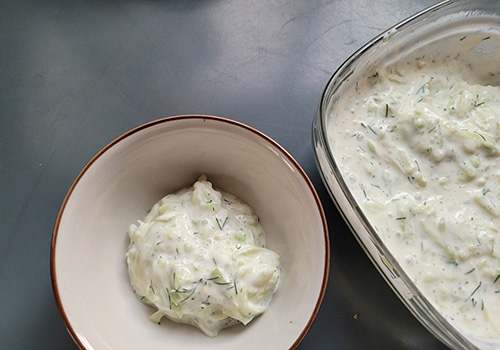
Potential Uses
This creamy refreshing dip is excellent with vegetables, grain pilafs, hummus, as a condiment for roasted herbed meats, and with Greek-style foods such as souvlaki or spanakopita.
Related: 1 Cup Before Bed Shrinks Belly Fat All Night (Video)
Dill Seed Tea
Ingredients
- 1 to 2 tablespoons of dill seed.
- 1 to 2 cups of boiled high-quality water.
Method
Step 1: Wait for the dill seed to ripen. This is the dill mentioned above that has infiltrated the carrot rows.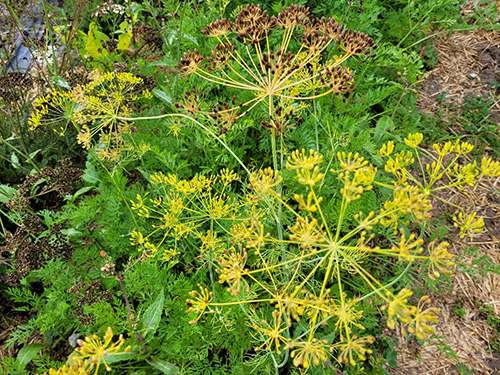
Step 2: Gather dill seed.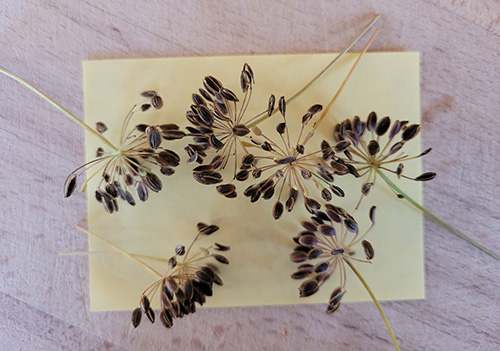
Step 3: Pluck dill seed and place in a mug. Cover with boiling water. Allow steeping for 10 to 15 minutes. Strain out the dill seed. Enjoy!
Potential Uses
This tea is delightfully calming and soothing throughout the digestive tract. A great time to drink this tea would be before or after a large meal or at any time there is digestion issues.
Dosage
Dill seed and oil have GRAS (Generally Regarded as Safe) status by the FDA. Currently, there is not enough scientific evidence to determine the appropriate dosage. Furthermore, several factors such as age, medical conditions, and overall health may influence the dosage amount.
How To Preserve Dill
Once harvested, it fades quickly. Fresh dill may keep its flavor for several days in the fridge if protected by placing in a glass container, gently wrapped in moist paper towel, or wax paper.
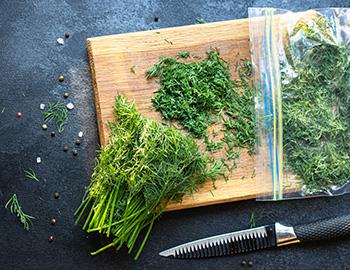
As described above, dill freezes well while retaining much of its fresh one-of-a-kind flavor. You can freeze whole sprigs on a cookie sheet in the freezer. Once frozen, place the sprigs in freezer bags or containers. I prefer to chop the herb up and place it in an airtight glass jar to keep in the freezer. This takes up less high-valued freezer real-estate.
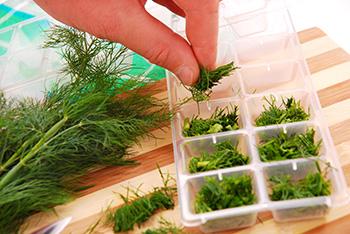
Also, it is easy to spoon the ready-to-go dill into any dish without having to mess around with chopping the frozen delicate lacy sprigs. Frozen plant keeps well for at least 6 months.
It does lose some of its fresh crisp flavor when dried. If I fill more than a couple of jars for the freezer, I dry the rest as dried dill lasts longer. Up to 18 to 24 months. It is best dried as quickly as possible. Using an herb dehydrator is a wonderful way to retain much of the flavor and color when drying the herb.
Related: How To Properly Dry Plants for Medicine (video)
What Plants Resemble Dill?
| Feature | Anethum graveolens, Dill | Petroselinum crispum, Parsley | Foeniculum vulgare, Fennel |
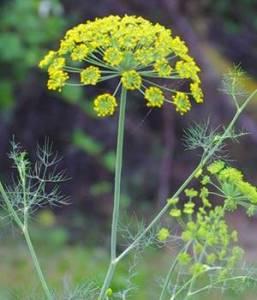 |
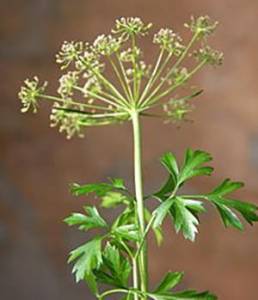 |
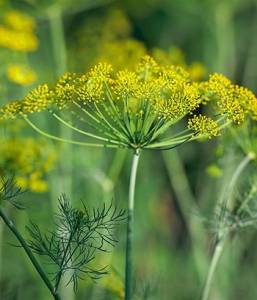 | |
| Growth Type | Annual | Biennial | Perennial |
| Size | 1 to 4 feet tall. | 2 to 2 ½ feet tall. | 2 to 8 feet tall. |
| Leaves and Stems | 4 to 8 inch long finely divided fern-like leaves. Stems are hairless, upright, slightly branching with white vertical lines. | Curly or flat leaves emerge from a basal rosette on 4-to-10-inch green stems. Second-year growth, the plant produces flower stalks. | Up to 16 inch long finely divided thread-like leaves. Stems are hollow and whitish-green. |
| Flowers | Small white to yellow flowers are born on 2-to-4-inch compound umbels. | Green to white, 2-to-4-inch flat umbels rise above the basal rosette in the second year of growth. | Tiny yellow flowers are born on 2-to-6-inch compound umbels. |
| Seeds | Bright green when young, turning brown when ripe, oblong seeds are less than ¼ inch long. | Oblong pale green seeds when young, turning brown when ripe, less than ¼ inch long. | Green, oblong seeds are less than ¼ inch long and half as wide. |
Warning and Cautions
As mentioned above, dill seed and oil have GRAS (Generally Regarded as Safe) status by the FDA. Dill weed is often consumed in foods and is considered likely safe. There is potential to an allergic reaction to dill. In particular, people with allergies to plants in the carrot family such as celery, caraway, coriander, asafetida, and fennel might take extra caution when consuming dill and dill products.
Again, dill is considered safe for topical use. Of course, with any new ingredient do a small skin test by placing a small amount of the oil, flowers, or dill weed on the skin and wait 24 hours. Any reaction such as itchiness or hives may be an indication of sensitivity. It only makes sense to practice some caution with topical use for people who suffer from allergies to other plants of the carrot family.
Always check with your healthcare provider before starting new herbal remedies.
You may also like:
 10 Remedies You Can Find In Your Kitchen
10 Remedies You Can Find In Your Kitchen
Similar to Morphine: The Best Natural Painkiller that Grows in Your Backyard (Video)
Foods And Herbs That Increase Libido and Others That Kill It
DIY Colon Detox with Ingredients You Have in Your Kitchen Right Now








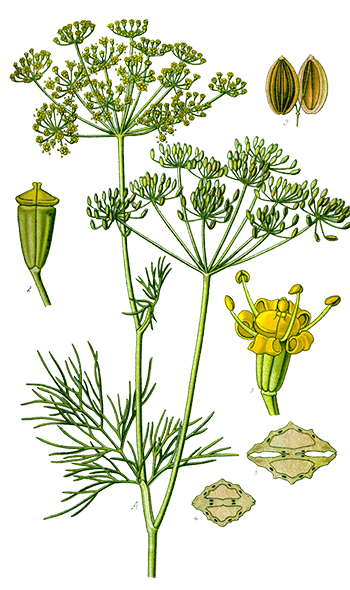
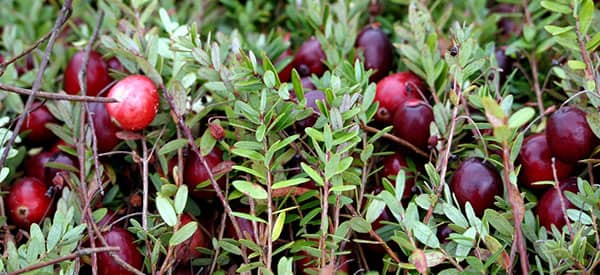
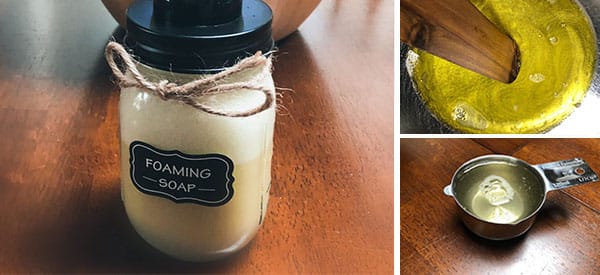
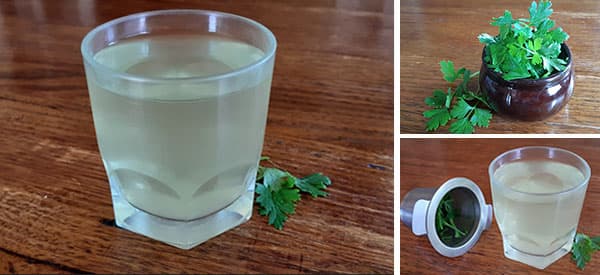
Awesome information God bless you and yours for sharing with us.
I learnt more about this from your Lost Book of Herbal Remedies. so grateful I have it
Oh thank you so much for this valuable information 😍